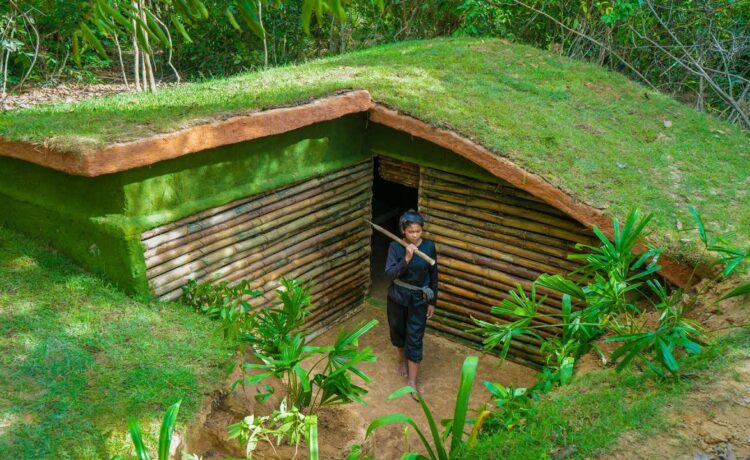If you are here, it means you are concerned about the inflating population or you are going to build yourself an underground house. Either way, this article is for you. It is not news that the earth’s population is shooting up, making us think it is too small to accommodate these many people.
As the population increases, water, air, land, and natural minerals become scarce, resulting in Resource scarcity, environmental degradation, climatic change, and a sustainability crisis.
One good way to stifle the situation is “Underground Houses.” The reasons Underground Houses are close to nature are Energy efficient, water conservative, natural ventilation, and reducing the impact on the environment. This article walks you through the 13 best underground homes and why subterranean houses are the future.
Scroll down to check out 13 sleek subterranean house designs!
1. Earth Sheltered Homes

As the name suggests, the house is built having earth as its shelter. Usually, the house is built at the ground level, and the earth is bermed around it. Besides fancy, it is built to have the earth as its thermal controlling system. Earth-sheltered houses are in perfect harmony with nature. The temperature of the house goes up and down by the earth’s surface.
Since the house is wrapped with the earth, it keeps the house warm in the winter and cools in the summer, cutting down the air conditioner and heater charges. Having a tranquil environment is elusive in packed houses. That way, earth-sheltered houses stand out.
2. Hobbit Houses

Hobbit in old English means, Hole-Dweller. The house is either built into the earth on a mountain or is entirely covered with plants and shrubs. It is close to nature houses. They are incredibly energy-saving since almost everything is built with natural elements.
It is resilient to man-made disasters such as nuclear attacks and bombs. It guards you against extreme temperatures and inclement weather. The maintenance is less to little since it is dug into a mountain. The major components are stone and wood. Ultimately man-made things are of no use. Hobbit houses are smaller than traditional houses, so cleaning and repairing are less required.
3. Bunker Houses

Bunkers, AKA reinforced underground shelters, is a natural pain houses because of their high resistance to natural calamities such as tornados and thunderstorms. Buker houses live for centuries than conventional houses. It is eco-friendly as well as durable.
Building a Bunker house may break your bank, but in the long run, it will yield. Over time the cost of artificial cooling, heating, cleaning, and repairing will be lesser.
However, a soil test is mandatory before entering to build a bunker house. In some areas, the radon gas level in the soil will be higher, which can be harmful to our health. Several other measures, such as waterproofing and insulation, should be checked to ensure safety.
4. Moat House

Moat houses come under Subterranean houses. Moats are usually water-filled ditches that surround the area. It guards you from natural calamities like heavy rain and flood. Moreover, a huge mass of water can be stored around you, so never go out of water. And not to rely on electricity to pump water.
The houses are built below the ground level, thus partially or surrounded by the earth. It has some perks as underground houses, such as energy efficiency and natural insulation.
Above all, being surrounded by water gives a sense of privacy and keeps your house away from prying eyes. The moat blocks out all the noises and maintains a serene environment.
5. Invisible Houses

An invisible house is technically neither an underground house nor a subterranean house. It can slightly be considered a subterranean house because it is built below the ground level and partially surrounded by the earth. Invisible house is on the list because it has some perks as in the other close-to-nature houses.
Invisible houses are opted for by people who want to be left aloof from society or by people who need some attention. Invisible houses can do both at the same time.
It got its name because of its blending nature with nature. Invisible houses feature materials like glass and mirror to blend in with the environment. Mostly, the houses are built on the hillsides or in forests for better camouflage. Invisible houses are not everyone’s thing. It depends on one’s preferences, but it best suits people who seek a stylish and sustainable house.
6. Cave House

Cave houses refer to living under the earth’s surface, either in a natural cave or a man-made cave. People mostly seek cave houses to reduce the impact of the environment on their houses. It is way more economical than conventional houses. The building costs are really low, and so is the maintenance cost.
Cave houses can be achieved only in mountain areas, thus natural ventilation and peace. Since they are specifically designed to collect rainwater, it is eco-friendly. Besides comfort, it renders privacy and safety.
All you gotta do is find a perfect spot to build a house that is not prone to natural calamities such as floods and tornados. Secondly, find a contractor who can work in ordinance to build an economical yet sustainable cave house.
7. Desert House

Desert houses are built partially or entirely built below the earth’s surface. It is built to take good advantage of the earth’s surface’s insulation. That way, the house is insulated by the earth, reducing the usage of electric resources.
As with every other underground house, they are built to accommodate a huge mass of water. Then you’d never go short of water. In summer, while the others are being air-fried above, you can live in peace below. Moreover, you can escape from elements such as hard winds, heavy rain, and dirt.
8. Tropical Houses

Tropical houses do not necessarily have to be underground houses. It can be built underground, above the ground, or partially below the ground. The reason tropical houses are on the list is because of the minerals used in building the house to invite the cool breeze in the tropical areas.
Tropical houses are mostly built above the ground level and have a lot of windows and doors to accommodate sunlight to avoid dark interiors. Ultimately, building the best tropical house is in the hands of the architect. The architect has to construct according to the climate and location. There are several types of tropical houses, such as Above-ground tropical houses, underground tropical houses, and semi-underground tropical houses.
9. Underwater Houses

Underwater houses are a type of underground house that is built underwater. They are built using materials such as concrete, steel, and acrylic. Underwater houses have several advantages over traditional above-ground houses. They are free of heavy wind, rain, dust, and heat. The house takes nature as its insulator.
The cherry on top is the stunning view provided by the underwater houses. It helps you connect to the underworld, which is away from jarring noises, traffic, and prying strangers.
However, it is susceptible to floods and some natural calamities and is prone to damage over time. Building an underwater house can cost you a lot and needs an effective contractor to build the house. It indeed takes elbow grease, but once you are all set, you can enjoy it for years.
10. Treehouse

A Treehouse does not come under underground houses. The only way it is associated with an underground house is that it is entirely built on a tree on a hillside. Unlike other houses, it is entirely built above the earth’s surface. It mostly takes steel, concrete, and wood to build.
It has disadvantages, such as being prone to damage and less durable. Advantages such as easy to build and cost-effective.
11. Arctic Houses

Some arctic houses can be considered underground houses. They are built entirely or partially under the ground level. They are built with materials such as whalebone, ice, steel, and concrete. They are built to take advantage of nature’s insulation. Artic houses save you from harsh rain and wind, which is pretty common in Arctic areas.
One kind of house built underground is a snow house, which is built by stacking ice. The drawback is they are not very durable. Houses built out of whalebone have good insulation but are very expensive and are not common as traditional houses.
12. Mountain Houses

Not all, but some mountain houses can be called underground houses. They have advantages such as giving a secure feeling, privacy, protection from the elements, and insulation. They can be economical since most of the house is dug into a cave, and electricity cost is almost cut off since you have ample sunlight.
However, it has some drawbacks, such as the high cost of building, difficulty in reaching the house, material availability (it requires some specific materials to build a house on the mountain), and high maintenance(since the mountain is damp, the chances of mold and algae is high).
13. Oceanfront Beach Houses

Oceanfront houses are built below the earth’s surface and are accessed through stairs or tunnels. They provide many benefits, including protection from the elements, privacy, and a splendid view of the sea.
On the flip side, it is elusive, considering the high cost of building the house. Subterranean houses can be difficult to access when built in a remote area or a difficult-to reach-place. The moisture in the air can affect the house.
Final Thoughts
Underground homes are a unique and fascinating type of housing. They offer several advantages, such as insulation, privacy, and security. They have some drawbacks too. If you want to build an underground house, weigh the pros and cons before proceeding.
Back then, underground houses were considered a fancy and novelty. But with the soaring population, it is pretty much the need of the hour to adapt to an underground house. It is incredible in several ways. It needs low maintenance and is in harmony with nature.
Although, it has some disadvantages, such as difficulty in finding a prospect if you are willing to sell it. If you are concerned for the Earth and want to pitch in on creating an eco-friendly house, underground houses are your thing.





